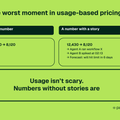Insights straight to your inbox
Join 10,000+ subscribers getting the latest insights on AI monetization.


Annual Recurring Revenue (ARR) has been the backbone of SaaS for two decades.
It gave investors predictable growth curves. It gave founders leverage in fundraising. It let boards sleep at night.
But ARR was never a really well defined metric. And now, it may be practically dead in Europe.
With the EU Data Act (effective September 2025), every SaaS contract with an EU customer becomes a “cancel anytime” subscription. Customers can walk away with two months’ notice. No excuses, no lock-in.
What's good for consumers is now good for companies too.
But if ARR is no longer “annual”, but rather optional - is it actually good for companies?
The EU Data Act is broad, covering connected products, IoT devices, and critically for SaaS: data processing services. Buried in the law is a simple obligation:
The usual trick that SaaS companies rely on, offering “discounted” three-year deals in exchange for lock-in, is all but gone. Long-tail penalties for early exit? Off the table.
Investors may still talk about ARR multiples, but in Europe, that revenue is a rolling suggestion, not a contractual guarantee.
Most founders are reacting to this by arguing about pricing models. Do we move to usage-based? Do we invent new discount mechanics? Do we pivot to prepaid credits?
But there’s a quieter, nastier risk nobody is preparing for: involuntary churn. That’s when services terminate without the customer consciously deciding to leave.
This would happen when credit cards expire and not updated, but now imagine this:
If your vendor has not designed the entitlements/contract correctly - this could result in a subscription terminated. Access revoked. Business workflows broken. It’s the equivalent of your electricity being cut off because you didn’t click “confirm payment” on a reminder email.
Here’s what this looks like in real life assuming there are no grace periods correctly implemented:
That’s not just lost revenue. That’s a trust breach. It turns one forgetful renewal into a multi-department escalation. And it’s happening at the exact moment SaaS teams are already battling rising churn rates.
You now need to start considering grace periods and a whole lot more.
To survive, you’ll need to make sure your product has renewals around business reality, not contract lock-in.
That means:
It’s table stakes if you want to retain enterprise accounts under the new rules, because ARR is no longer enforced by contract. It’s enforced by customer satisfaction.
Going forward, your growth curve depends less on how clever your contracts are, and more on how resilient your operations are when customers forget, delay, or mismanage renewals.
Most founders will see this as a compliance nightmare. The smart ones will turn it into differentiation.
Retention, under the EU Data Act, is no longer a passive outcome.
Welcome to the new normal: ARR as a reflection of customer reality, not contractual fantasy.
Additional reading:
Join 10,000+ subscribers getting the latest insights on AI monetization.



Price smarter. Protect margins. Grow revenue.